In this tutorial, you will learn how the Shell Sort Algorithm works. Also, you will find working examples of shell sort in Python.
Shell sort is an algorithm that first sorts the elements far apart and successively reduces the interval between the elements to be sorted. It is a generalized version of the insertion sort.
In shell sort, elements at a specific interval are sorted. The interval between the elements is gradually decreased based on the sequence used. The performance of the shell sort depends on the type of sequence used for a given input array. Some of the optimal sequences used are:
- Shell’s original sequence:
N/2 , N/4 , …, 1 - Knuth’s increments:
1, 4, 13, …, (3k – 1) / 2 - Sedgewick’s increments:
1, 8, 23, 77, 281, 1073, 4193, 16577...4j+1+ 3·2j+ 1 - Hibbard’s increments:
1, 3, 7, 15, 31, 63, 127, 255, 511… - Papernov & Stasevich increment:
1, 3, 5, 9, 17, 33, 65,... - Pratt:
1, 2, 3, 4, 6, 9, 8, 12, 18, 27, 16, 24, 36, 54, 81....
How Shell Sort Works?
- Suppose, we need to sort the following array.

- We are using the shell’s original sequence
(N/2, N/4, ...1) as intervals in our algorithm.In the first loop, if the array size is
N = 8then, the elements lying at the intervalN/2 = 4are compared and swapped if they are not in order.- The 0th element is compared with the 4th element.
- If the 0th element is greater than the 4th one then, the 4th element is first stored in
tempa variable and the0thelement (ie. greater element) is stored in the4thposition and the element stored intempis stored in the0thposition.

Rearrange the elements at n/2 interval This process goes on for all the remaining elements.

Rearrange all the elements at n/2 interval
- In the second loop, an interval of
N/4 = 8/4 = 2is taken and again the elements lying at these intervals are sorted.

Rearrange the elements at n/4 interval You might get confused at this point.

All the elements in the array lying at the current interval are compared. The elements at 4th and
2ndposition are compared. The elements at 2nd and0thposition are also compared. All the elements in the array lying at the current interval are compared. - The same process goes on for the remaining elements.

Rearrange all the elements at n/4 interval - Finally, when the interval is
N/8 = 8/8 =1then the array elements lying at the interval of 1 are sorted. The array is now completely sorted.

Rearrange the elements at n/8 interval
Shell Sort Algorithm
|
1 2 3 4 5 |
shellSort(array, size) for interval i <- size/2n down to 1 for each interval "i" in array sort all the elements at interval "i" end shellSort |
Python Examples
|
1 2 3 4 5 6 7 8 9 10 11 12 13 14 15 16 17 18 19 20 21 22 23 24 |
# Shell sort in python def shellSort(array, n): # Rearrange elements at each n/2, n/4, n/8, ... intervals interval = n // 2 while interval > 0: for i in range(interval, n): temp = array[i] j = i while j >= interval and array[j - interval] > temp: array[j] = array[j - interval] j -= interval array[j] = temp interval //= 2 data = [9, 8, 3, 7, 5, 6, 4, 1] size = len(data) shellSort(data, size) print('Sorted Array in Ascending Order:') print(data) |
Complexity
Shell sort is an unstable sorting algorithm because this algorithm does not examine the elements lying in between the intervals.
Time Complexity
- Worst Case Complexity: less than or equal to
O(n2)
Worst-case complexity for shell sort is always less than or equal toO(n2).According to the Poonen Theorem, worst case complexity for shell sort is
Θ(Nlog N)2/(log log N)2)orΘ(Nlog N)2/log log N)orΘ(N(log N)2)or something in between. - Best Case Complexity:
O(n*log n)
When the array is already sorted, the total number of comparisons for each interval (or increment) is equal to the size of the array. - Average Case Complexity:
O(n*log n)
It is aroundO(n1.25).
The complexity depends on the interval chosen. The above complexities differ for different increment sequences chosen. Best increment sequence is unknown.
Space Complexity:
The space complexity for shell sort is O(1).
Shell Sort Applications
Shell sort is used when:
- calling a stack is overhead. uClibc library uses this sort.
- recursion exceeds a limit. bzip2 compressor uses it.
- Insertion sort does not perform well when the close elements are far apart. Shell sort helps in reducing the distance between the close elements. Thus, there will be less number of swappings to be performed.

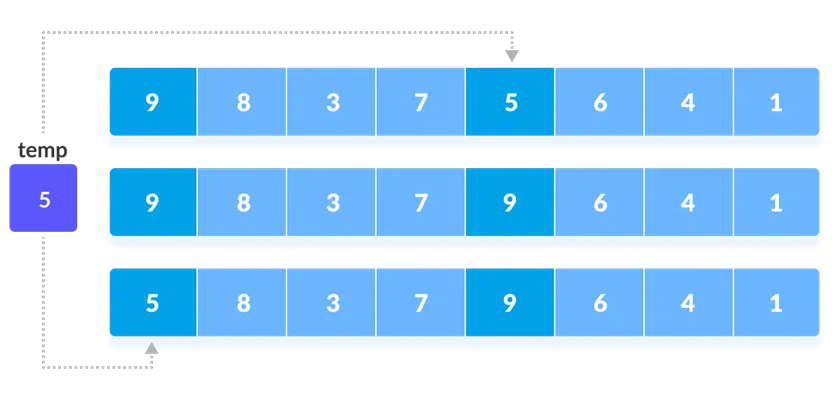
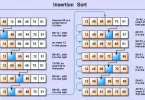
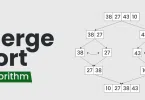
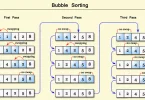
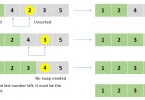
Leave a Comment